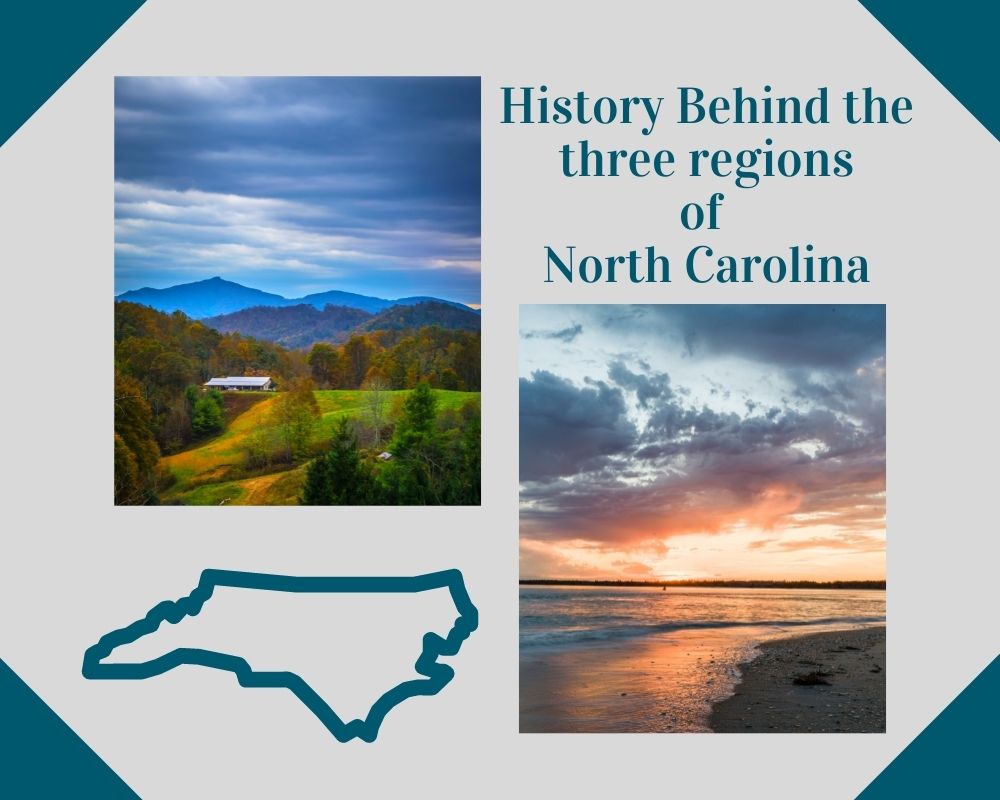History Behind the Three Regions of North Carolina
History Behind the Three Regions of North Carolina
North Carolina is the ninth-most populous and 28th largest of the 50 states. To the north, it is bordered by Virginia; to its east lies the Atlantic Ocean. South Carolina and Georgia sit by the South, and to the west is where you’ll find Tennessee. The state’s capital is Raleigh, while its largest city is Charlotte, where the Charlotte metropolitan area has an estimated population of 2,569,213 as of 2018.
Moreover, the Raleigh-Durham-Cary combined statistical area is where you’ll find Research Triangle Park, the biggest research park in the country. Split between three main regions, these North Carolina sections are known as the mountain region, the Piedmont region, and the coastal plains region. Here, we explore each section and talk about their history, the origins behind their names, and the vibrant cities they have in store for you.
The Mountain Region
The Mountain Region is located on the westernmost part of the state and makes up a smaller area compared to the Piedmont and Coastal Plain Regions. Containing some of the most complex and oldest geographical formations in the world, the Mountain Region was appropriately named. Additionally, it is home to the Blue Range Mountains, which separate it from the Piedmont Region. Because of this great wall, the Mountain Region was the last area in North Carolina to be reached by the European Settlers.
History
The Cherokee Indians were the most notable Native Americans to have settlements in the present-day North Carolina mountains. The first known contact between the natives and the Europeans occurred in 1540, when Hernando de Soto, a Spanish explorer, and his men came in search of gold. However, contact between the two was limited until the late 1600s, which developed into a thriving trade between the White settlers and the Cherokee during the early 1700s.
Around 1784, the earliest permanent white settlers came to the Swannanoa area, which is known as Buncombe County today. Some of these early settlers were the Pattons, Gudgers, Alexanders, and Davidsons. In the late 1700s, more and more migrated into the surrounding areas west of the Blue Ridge Mountains, and the Cherokee who lived there moved to the west. As a result, migration into present-day Henderson, Transylvania, and Buncombe Counties grew at a rapid pace.
Because new settlers found it hard to travel through the rough, steep, and muddy roads to the county seats in the Wilkes, Burke, Rutherford Counties to conduct all kinds of business, they asked the legislature to establish new counties closer to their area. The legislature established Buncombe County in 1792 and Ashe County in 1799. Many of the settlers in the mountains were of Scotch-Irish, German, and English descent, who came to buy, settle and farm the fertile and cheap hillsides and bottomlands of the region.
Some settlers had migrated from North Carolina’s coastal plain and Piedmont regions, who came by foot, horseback, or wagon. They entered the area through gaps found in Hickory Nut, Deep Gaps, Gillespie, and Swannanoa. Furthermore, other Scotch-Irish, German, and English settlers found their way in through Maryland, Virginia, and Pennsylvania. These settlers made their way starting from the Great Wagon Road, through the Piedmont Region, and then traveled west to the mountains.
NC Mountain Region Cities
Some of the Mountain Region’s most prominent cities are:
- Asheville: This scenic mountain city is home to around 85,000 people and is known for its liberal culture, Art-Deco architecture, and cultural establishments.
- Cashiers: This city is nestled in the wooden mountainside of the Blue Ridge Mountains’ southernmost part. A charming town that’s surrounded by a scenic green valley, it’s neighboring mountains rise over 5,000 feet.
- Robbinsville: This is a mountain retreat located in Graham County where you’ll find water recreation, leisurely drives, Appalachian crafts, hardy hikes, and great history.
- Other cities found here include Boone (which is home to Appalachian State University), Hickory, West Jefferson, Highlands, Hendersonville, and Lenoir.
Piedmont
At the center of the region lies Piedmont, which is located between the Mountain and Coastal Plain Regions. Its name originates from the French word that means “foot of the mountain.” Elevations here can range between 300 feet closer to the Western Coastal Plain to around 1,500 feet closer to the mountains. Lastly, the land within the Piedmont area is referred to as a plateau since it is mostly flat and high.
History
Settlers from Europe remained mostly in the Coastal Plain Regions of North Carolina. This changed when they moved around 40 years before the American Revolution took place. The boundaries that separated Piedmont from the Coastal Plains (called the fall line) had many rapids and waterfalls which made traveling more difficult.
At first, this discouraged migration, but once settlers arrived in Piedmont, they came in huge numbers. This resulted in the rapid rise of North Carolina’s population growth, which had doubled in just a decade between 1765 to 1775. With clay soils and limestones that support grasslands and forests, this backcountry is much different from the Coastal Plain Region.
Its shallow streams and narrow rivers also provided excellent sites for farms and mills, where Scotch-Irish settlers (descendants of Scots who moved to Northern Ireland) formed farmland. These settlers had prospered until changes in policies led them to leave Ireland and look for opportunities in America. Most had settled in Pennsylvania but moved to North Carolina during the 1730s.
These Scotch-Irish settlers used these lands to grow wheat and corn to use in their homes and tobacco for export and use. Additionally, they raised livestock and sold them in the northern markets in large numbers. Settlers here built sawmills, tanneries, stores, and gristmills, while many local industries were established such as carpenters, blacksmiths, coopers, rope makers, potters, wagon makers, and wheelwrights.
Germans from Pennsylvania also arrived at Piedmont, where many settled next to the Yadkin and Catawba Rivers. In 1753, Moravians, who were also from Germany arrived in present-day Forsyth County, where they started building a strictly controlled congregational community. Within these settlements, pieces of land were held in common but occupations, crafts, and marriages needed the approval of community boards.
NC Piedmont Cities
The Piedmont region is home to many of North Carolina’s well-known cities, such as:
- Raleigh: The state’s capital city and is a cultural hotspot.
- Chapel Hill: This city serves as home to the Carolina Tar Heels.
- Cary: This fast-growing city is located right between Raleigh and Research Triangle Park and hosts SAS, the biggest private software company in the world.
- Greensboro: One of the state’s biggest cities and is located close to the northern center.
- Charlotte: This is the biggest city in the Carolinas and the center of culture and commerce in the region.
Coastal Plains
This low and flat land sits along the Atlantic Ocean and was appropriately named after this feature. This region is often split into two parts: the Inner Coastal Plain and the Outer Coastal Plain. The Inner Coastal Plain is a dry and high area with rich and sandy soil where the state’s best farmland is located. On the other hand, the Outer Coastal Plain can be further divided into the Outer Banks and Tidewater region.
History
This region went through drastic changes from the 1650s to the 1770s, where European-American settlers arrived and drove the Native Americans away — they had lived here for thousands of years. Unfortunately, many African Americans and Africans were forced into slavery during their time here. Many were imported from other countries while others came with European settlers.
By the mid-1720s, many of the permanent settlers had arrived around the lower parts of the Cape Fear River. This migration is primarily due to the efforts of North Carolina’s governor, George Burrington, and South Carolina’s planter, Maurice Moore. During this time, settlers from South Carolina were also fleeing high taxes, economic depression, and political unrest.
Many other settlers had come from the colonies of New York, Massachusetts, Maryland, and Pennsylvania, along with immigrants from Scotland, England, and Ireland. In the 1730s, the Scotch-Irish and Welsh started settling in this region, with the Swiss from South Carolina joining them by the time the mid-1730s came. A few more years passed and lowland Scots (many of whom were merchants) also came to the state in an attempt to improve their fortune.
Eventually, highland Scots also made their way here, with the first group arriving in 1739. In the following years, more settlers came, where they developed present-day Anson, Fayetteville, Cumberland, Bladen, Home, Moore, Harnett, Robeson, Richmond, Scotland, and Sampson Counties.
NC Coastal Region Cities
The Coastal Region is home to many cities, each with its own unique features.
- Carolina Beach
- Southport
- Elizabeth City
- Fayetteville
- Jacksonville
- Greenville
- Ocean Isle
- Rockingham
- Wilmington
North Carolina has plenty to offer, so there are many reasons why you should pack your bags and come visit. Whether you’re looking for diversity, history, culture, places of interest, or more, the Tar Heels state will be able to entertain, educate, and keep you looking for more. What are you waiting for? North Carolina welcomes you to have the grand adventure you’ve always wanted.






